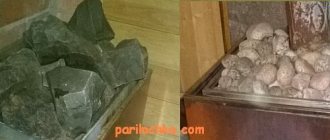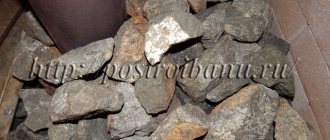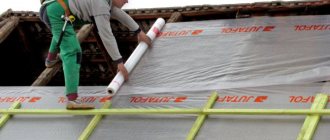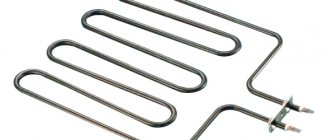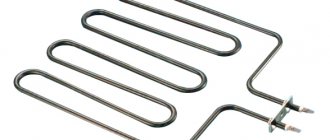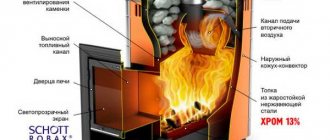The best stones for a sauna should have several basic properties: high thermal conductivity, excellent heat transfer, fast heating and safety. It’s not pleasant when a stone bursts in the steam room, scattering into small fragments. The choice must be approached carefully: avoid specimens with cracks and an abundance of veins. This top will help you choose useful stones for any steam room, sauna or classic bath.
Soapstone chlorite
pros
- resistant to temperature changes
- high heat capacity
- does not absorb water
- gives off heat for a long time
- does not enter into chemical reactions with liquids
- does not absorb odors
Minuses
- service life 3.5 years
- takes a long time to warm up
Natural stone, extracted from rocks. It tolerates high temperatures well, does not crumble or crack. It can heat up to 1600 degrees; when it cools, it releases vitamin D, which is especially useful for children for growth and strengthening bones. Suitable for both heat in a steam room and for lining walls. Produces soft steam and pleasant heat radiation.
Collect or buy stones?
get stones for the heater yourself, for example, by collecting them along river banks or on mountain slopes. Samples found near fresh water bodies outperform sea pebbles, a less durable material, although both the former and the latter have undergone centuries of treatment by the sun, wind and water.
The most popular rocks are: jadeite, gabbro-diabase, soapstone and some others, characterized by heat resistance and strength. Less resistant to high temperatures, but having unique and beneficial properties for humans, are basalt, crimson quartzite, and white quartz.
Before determining which stones are best used for a bath , you need to decide where to look for them: buy them in specialized stores or mine them yourself, for example, along the banks of a river.
The first option is preferable and more convenient, but more expensive. The second is free, except for the investment of time and effort, but in the absence of experience and knowledge about stones, it is even unsafe. Especially if there is a temptation to arrange a gathering on a railway embankment.
According to their physical characteristics, these stones may well be suitable for a steam room, but it must be taken into account that they are treated with chemical reagents, which not only emit an unpleasant aroma when exposed to high temperatures, but also produce evaporation that is dangerous to humans. And this is not counting the fact that the mound, in principle, is neither a source nor a supplier of stones for the heater.
An undeniable advantage of buying stones in specialized stores is the opportunity to purchase stones of the desired type, and not just those that can be mined in the natural environment.
Also, in the absence of specific knowledge, you can get the necessary advice from specialists, for example, on how to choose stones for a heater in a bathhouse or how to properly lay them in masonry.
In the store you can purchase a ready-made set of stones, balanced both in composition and size, which have necessarily been treated with special compounds against various microorganisms, including pathogens and aggressive ones towards the human body.
Types of stones for baths, video:
Jade
pros
- very durable
- heats up quickly
- polished looks nice
- good heat capacity
- keeps warm for a long time
Minuses
- price
There are 3 types: chipped, boning and polished. When comparing the properties of bath stones: the latter is the most expensive and looks like jade (light green), its service life is 5 years. Gives soft warmth and lasts for a very long time. Suitable for cladding; tiles for steam rooms are made from jadeite. Avoid contact with open flames.
Dunit
pros
- lasting
- high thermal conductivity
- uniform heat
- disinfects the air
- maintains temperature for a long time
Minuses
- with a high percentage of sulfur in the composition it breaks down into parts
- gloomy look
Dunite is soapstone, which is located deeper, igneous rock, absolutely free from radiation. When choosing, you need to focus on the number of sulfur veins; if there are more than 5% of them, you should refuse the purchase. It heats up quickly and well, and also cools quickly, durable (if it is of high quality). Suitable for the first layer of stones, as it is not visually attractive.
How to properly care for stones in a steam room
Even such a durable material as natural stone , especially used in extreme conditions of a bath or sauna, becomes unusable after some time. This explains the reduction in heat output of furnaces by 15-30% per year (depending on the intensity of operation).
It is recommended, on average, once a year (and sometimes more often, if the steam room is used intensively) to conduct a thorough inspection of the stones, after removing them from the oven: identified defects and damage are a reason for replacement.
The rest should be washed under running water and re-laid. The ideal option is to completely replace the stones every 1-2 years, but this is not necessary, especially if the sauna is not used constantly.
When installing a stove, it is important to correctly calculate how many stones are needed for a bath or sauna . It is always difficult for beginners in the bath business, but if you use the rule of 5-6 kg/m2, then you can be sure that the desired effect from their use will be achieved. You can also use another calculation scheme: 1 part of stones per 50 parts of steam room volume.
The type of stove and the shape of the heater must be taken into account: closed or open. In the first case, a higher temperature is provided, so the selected stones must withstand it. In an open heater, the maximum temperatures are much lower, therefore, deciding which stones to choose for a bath will be easier, since it is possible to use less heat-resistant samples.
Mistakes when choosing a stone for a stove, video:
Raspberry quartzite
pros
- record low radiation levels
- Maintains room temperature for a long time
- beautiful colour
- is not destroyed by chemical reactions with liquids
- high hardness
- withstands temperatures up to 2700 degrees
Minuses
- Often there are copies with cracks in boxes
Very beautiful dark crimson color, withstands high temperatures, minimal radioactivity. Heats up quickly and gives soft warmth. According to reviews, it helps against respiratory and cardiovascular diseases. It consists of 93% quartzite, heats up smoothly, and releases heat evenly. Suitable for long-term use, often used in public baths. There are many copies with cracks, you need to control this when purchasing.
What to choose?
Yes, we've finally reached this point. Here we can give you two good directions to think about.
Universal option
Jadeite or jade, they are suitable for any stove. Jadeite is a little better, but a little less durable. These minerals can be safely recommended to everyone. If you don’t want to worry about it, but just go and buy, then this is your option.
If you are not satisfied with the price, then pay attention to soapstone. It performs well, is safe, and is durable enough that you won't regret the purchase. Even experienced bath attendants respect this stone.
According to the furnace design
So, for example, if stones come into contact with the metal structure of the stove or open fire (continuously or occasionally), i.e. are exposed to high temperatures, then you should choose the most heat-resistant stones :
Chromite
Vulcanite
Soapstone chlorite
If the stones are not subjected to extreme loads, then the classic options are your choice:
jadeite and jade
gabbro-diabase
It’s probably worth making an important caveat here. After all, to tell the truth, any of the previously listed stones are absolutely suitable for use. If a stone is on this list, then it already deserves to be in your oven. And the disadvantages that we are finding fault with here are not that significant.
Basalt (volcanic)
pros
- the best breed for a bath
- refractory
- soothing, good for blood circulation
- long service life
- retains heat well
- the most durable
Minuses
- not detected
The best stones for the stove are of volcanic origin. Black in color, has high thermal conductivity, gains temperature well, and releases heat slowly. Withstands many cycles of temperature changes. Very durable, according to experts, there is a high chance that you will never need to change it at all, it will last for the entire service life of the bathhouse.
Rating of the best models in the mid-price segment
Heat contact polished jadeite for baths and saunas
A high-quality option that will last 4 years, but only with proper care. High lithotherapeutic properties are an additional feature of the product. The product is suitable for use in both baths and saunas. Sold in convenient packaging. Oval shape, easy to install. Hardness on the Mohs scale is 7 points, which is comparable to some metals.
The average cost is 4,800 rubles per 20 kg.
Heat contact polished jadeite for baths and saunas
Advantages:
- Greenish tint;
- Easy installation;
- Service life – 4 years;
- Does not break;
- Does not deteriorate from heating;
- Doesn't crack.
Flaws:
- Price.
Tylo
A good option, but it is only suitable for those who use an electric stove in their bathhouse. Heating occurs quickly and evenly; when water enters, thick but soft steam is released. The shape is normal, installation does not take much time. There are no impurities in the composition, the structure is completely homogeneous. The small size helps to warm up quickly, but in addition, heat is retained well.
Sold at a price: from 3,200 rubles.
Tylo stones
Advantages:
- Attractive execution;
- Convenience;
- Doesn't take up space;
- Good heating;
- Long service life;
- Reliability.
Flaws:
- Only for electric ovens.
Harvia Jadeite Khakassia 20 kg
Large crushed stone, which is sold at an affordable price. Despite this, there are no harmful substances in the composition, so the products are completely safe for health. Sold in a convenient plastic bucket. Heating does not take time, and the product does not crack and retains its properties for a long time. It is convenient to place in the oven, but at first it will be unusual, since there is no shape as such.
Sold at a price: from 2,600 rubles.
Harvia Jadeite Khakassia 20 kg
Advantages:
- Long service life;
- Reliability;
- Does not crack;
- Price and quality;
- Popular manufacturer;
- Convenient bucket.
Flaws:
- Not detected.
JadeBest Jadeite Polished 1st Grade Selected
A high-quality option that is suitable for every bath. Each stone has been thoroughly tested to ensure it contains no harmful substances. Sold in convenient packaging (20 kg). Designed for use in a bath or sauna. The mineral has healing properties, and after the bath the effect lasts for a long time. The fractions are large, which should be taken into account when laying out.
The average cost is 3,600 rubles per 20 kg.
JadeBest Jadeite Polished 1st Grade Selected
Advantages:
- Healing properties;
- Greenish tint;
- Careful control;
- Does not crack or crumble;
- Convenience.
Flaws:
- Not detected.
White quartz
pros
- spectacular white color
- heats up quickly
- gives off heat well
- cools down slowly
- fragrant
Minuses
- when broken, forms sharp edges
- cannot withstand high temperatures
The vein rock breaks over time due to frequent temperature changes; you need to monitor the condition and replace it with a new one if cracks appear. Beautiful white color, looks impressive in combination with dark stones. It is believed that it produces ozone, which is why it is called hot ice, but no research has been conducted on this topic. It has only been proven that energy accumulates on the surface and a piezoelectric effect appears. Suitable for saunas that do not heat up very much (in fitness clubs, swimming pools).
Why isn't it that simple?
To begin with, to make it a little clearer what will be discussed further, let’s briefly go over the basic requirements for the characteristics of our stones:
- Safety . Perhaps the most important point. And yes, this is really important for two reasons at once: carbonates and background radiation.
- Shape, size and uniformity . All these characteristics are responsible for the parameters we need most: uniformity of heating and heat transfer. The ideal shape and proportion is a smooth and uniform oval or even round stone the size of a fist.
- Heat resistance and durability . This may seem obvious, but you don't want to change stones every few months?
- Heat capacity and thermal conductivity . Everything here is quite simple, because the longer the stone gives off heat and the faster it warms up, the more effectively it copes with its direct task.
What are carbonates? These are whitish inclusions on the stone that will gradually evaporate into the air. This, of course, is not fatal, but extremely undesirable. If you wanted to breathe dust, you would go to the mine, not to the bathhouse.
With radiation, everything is a little more complicated, and not every bathhouse attendant has Geiger counters at hand. Unfortunately, this can only be avoided by choosing the stone material, but more on that below.
So what will we choose from? Let's see what the bath stones market offers us.
Bath stones
Gabbrodolerite
It sounds impressive; it is found in stores under the name “gabbro-diabase.” The most popular budget option.
The main advantage is its price with more than acceptable characteristics. It is environmentally friendly, safe and will last at least a couple of years even with active use. However, it has a fairly low heat capacity and can give off an unpleasant odor if overheated.
Jadeite and jade
Also extremely popular, but not nearly as cheap options.
Good at absolutely everything. They don't even have any downsides as such. One could say that these are ideal options for natural stone for a bath, but the price is steep.
Vulcanite, aka volcanic basalt
A good budget option without any obvious disadvantages. A stable middle peasant in the world of bath stones. It survives temperature changes well, so it will last quite a long time.
Dunit
Budget replacement for jadeite. Good for everyone, but to a lesser extent. May contain sulfides, so if overheated it will give off an unpleasant odor.
Porphyrite
Not very recognized by bath attendants, but a suitable and inexpensive breed. The bathhouse will not last longer than a couple of years with active use, but it has no other disadvantages. May also contain sulfides.
The presence of sulfides can be determined visually. They look like metal veins.
Soapstone chlorite
It is believed that the steam from soapstone helps in strengthening the immune system.
A good option with excellent heat capacity and thermal conductivity, but we recommend warming up and rinsing the stones before use, otherwise they may become dusty. One of the main contenders for the crown after jadeite.
Raspberry quartzite, also known as Shoksha quartzite
Our guest from Karelia. Considered useful for stabilizing blood pressure.
The most durable option, even more reliable than jadeite. However, be careful with cracks and chips - there should not be any, otherwise the stone may begin to “stain.”
Porcelain
Fake diamond.
Don't be alarmed, these ceramic balls are more heat resistant than all of the above (except chromite). And in terms of their other characteristics they can compete with them. As a rule, porcelain balls are used in combination with natural stones.
Chromite
An extremely heat-resistant representative, capable of surviving temperatures that other stones have never even dreamed of.
In terms of other parameters, it is a strong middle peasant on the list.
Jasper
Beautiful, but short-lived.
Of course, you can use a bath stone, but you need to be prepared for the fact that you will have to pay for the beautiful appearance by frequently replacing cracked stones.
river pebbles
Free stones.
Why not? If you have somewhere to collect it, then use it for your health. But pebbles may contain iron oxides, they look like red veins - it is better to throw away such stones.
And a little about a bad choice for bath stones:
Serpentinite, also known as serpentine
It is sold along with other stones, but is a dubious purchase due to its fragility.
Quartz
An interesting option from an aesthetic point of view, but otherwise it’s a complete disadvantage. We definitely won't recommend it.
Is it clear that nothing is clear? Let's try to choose.
Peridotite
pros
- does not contain harmful impurities
- high specific heat capacity
- does not crack
- takes a long time to cool down
- creates thick steam
Minuses
- service life up to 3 years
One of the safest, environmentally friendly. Able to withstand many cycles of temperature changes, cracks will not appear. High melting point (1850 degrees), heat transfers well, releases for a long time, the steam is thick and rich. Capable of withstanding heavy loads. Suitable for sauna stove.
Basic rules for using stones and some advice from bathhouse attendants
Experienced bathhouse attendants recommend some actions that will help you get the maximum benefit and pleasure from bathing procedures using stones. Thus, it is recommended to disinfect bath stones from time to time, because during use the stones are exposed to water, steam and temperature - some rocks may be subject to the formation of harmful plaque, mold or fungi. To disinfect stones, they are soaked in a large container (for example, in a basin or bucket) for about a day, using an ordinary salt solution (proportion 1 to 3). After soaking for a day, the stones should be thoroughly rinsed and dried.
In addition to disinfecting stones, bath attendants also recommend using other tricks.
Porphyrite
pros
- good heat capacity
- low radioactivity
- inexpensive
- light pleasant steam
- heats up quickly
Minuses
- low strength
- contains sulfides
Its composition is similar to jadeite (oxides of silica and metals). Due to sulfides, it is less durable and can withstand temperature changes for about 2-3 years. Environmentally friendly, free from radiation. Creates thin, light steam. Suitable for those who rarely use the sauna. When purchasing, you need to check the number of veins in the stone (no more than 5%).
What is the best stone for a bath?
There can be no definite answer here. We said:
- the most durable - jade, ceramics and stainless steel;
- the most heat-intensive is porphyrite;
- the safest are jadeite, dunite, peridotite (and all of them are not immune to sulfides, by the way)
- the cheapest is gabbro-diabase.
And if we add to this what the owners of saunas with heaters filled with jade say... The quality of the steam also matters, right?
Therefore, we are still forced to cheat a little and say a completely expected banality:
- if you have the financial opportunity , it is worth buying jade, jadeite, ceramics and stainless steel;
- if the bathhouse is budget , then it is better to opt for porphyrite, gabbro-diabase and dunite.
And, of course, you are free to mix stones - natural or artificial - at your discretion.
We do not recommend taking quartz, basalt, serpentine (serpentinite) , rodingite, granite and jasper.
Soapstone is better than soapstone because magnesite is more heat resistant than chlorite.
If our opinion is not enough, read user reviews and the rating (in the compilation of which, by the way, each of you can take part).
Cast iron stones
pros
- heat up very quickly
- durable
- long service life
- no harmful impurities
- keep warm for a long time
Minuses
- the steam is dry and hot
Cast iron is used in the form of kernels or cones, placed at the very bottom of the furnace “on the butt”. Cast iron heats up well, 5 times faster than stones. Afterwards it holds the temperature for a long time. The elements are usually the same in shape and take up less space. Suitable for quickly heating up baths, environmentally friendly.
How to properly place stones in a sauna stove?
Choosing the right stones for your bath is only half the battle. It is also necessary to prepare them correctly, and then put them in the heater.
After the stones have undergone a thorough external inspection to look for defects and cracks, it is recommended to pre-treat them in a weak salt solution for 1-2 hours.
Before placing stones in the sauna stove, they need to be washed and dried naturally.
After that:
- large specimens are placed in the lower part of the heater;
- then – average;
- at the top - small, at least 5-6 mm in diameter.
It is also possible to use stones of the same size; in this case, it is preferable that the diameter be in the range from 7-8 to 15 cm.
If the stove is iron and small in size, then you should not use very large samples; it is enough to stay at medium sizes. For electrical products, small stones placed in fairly narrow spaces between the heating elements would be a suitable option.
In some cases, recommendations to use large or medium-sized stones for large wood-burning stoves are rationally justified. In this case, proper heat exchange is ensured. When laying tightly, if small stones are used, this process is somewhat difficult. But not everything is so simple.
In any case, steam and heat will find loopholes to escape, so this point is not so relevant. Especially if you look at the process from the other side. If there are no small stones in the heater, water may get on the metal. In this case, the result is a rather unpleasant, “hard” feeling of steam, sometimes even with a specific metallic taste.
The use of small stones, especially when combined with large specimens, is also supported by an increase in the overall specific heat capacity of the stove. If stones of medium or fine fraction are used, the packing density increases, and this affects the quality of the steam due to the fact that the water rolls down more slowly and reaches the lower, hotter layer, and does not evaporate on the way to it.
The steam is softer and drier. It is based on this principle that one should be guided when the question arises about which sauna stones are better , as well as what size they should be. Even taking into account the fact that steam production is not expected in this case.
It is also important to correctly carry out the hardening procedure for masonry. To do this, you need to gradually heat the stones until they turn red in the lower part, then suddenly pour water on them, cold of course.
After waiting for the stones to cool completely, conduct a visual inspection for the appearance of defects and, above all, cracks; if necessary, reject low-quality specimens and replace them with new ones. In the event that more than 30% of the stones have to be shifted, the hardening procedure should be repeated.
Of course, proper placement of stones in a sauna stove ensures better heat transfer and steam formation, but it is important to monitor the quality and purity of the water used for the stones. There must be a hot and clean liquid, even if special aromatic additives are used. This guarantees not only more steam production, but also preserves the stones.
Laying stones in a sauna stove, video:
Nephritis
pros
- high strength
- the most durable (up to 10 years)
- can be used on open fire
- heats up quickly
- high heat transfer
- the steam is soft
Minuses
- price
The ranking of bath stones puts jade in first place. It is characterized by durability and high thermal conductivity. Heats up very quickly, the steam cleanses, soothes, improves metabolism. Suitable for any heater, the only negative is that it is expensive. Because of this, it is often crafted; in order to distinguish the original, you need to hit it with a hammer - real jade does not split. It is sawed to be cut into pieces.
How to use
It is important to carry out regular cleaning and inspection. The need to replace the stove filler may be indicated by the appearance of an unpleasant odor, minimal heat transfer, or poor steam formation. In regularly used saunas, minerals are inspected every month. Care instructions:
- Clean off dirt with a metal brush.
- Rinse in a container with clean water without using soap solution or powder.
- A clean stone should be left in water for up to 1.5 hours until it becomes slippery.
- It is recommended to dry the minerals in a well-ventilated area, otherwise fungus will begin to form on the surface.
- Each element should be lightly tapped with a hammer. A loud sound indicates durability and serviceability, a dull sound indicates the need for replacement.
- Cracked specimens must be removed, filling the oven with new ones.
- Oil stains are practically impossible to remove, so the stones are placed with the clean side up.
For a pleasant aroma inside the steam room, you can hang bouquets of lavender and mint on the walls, fill a container with water and essential oil and hang it over the stove.
